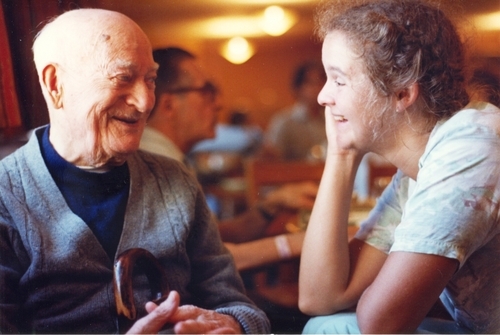Holmes, Philip D. P.: my Air Force recollections (January 11, 1984)
Interviewee: Holmes, Philip D. P., b. 1924
Interviewer: Witzel, Morgen
An interview/narrative of Philip D. P. Holmes's experiences during World War II. Squadron Leader Holmes, D.S.C. served with the Royal Canadian Air Force. Interview took place on January 11, 1984.
Rank: Squadron Leader. Medals and Honours: Distinguished Service Cross (DSC)
ABSTRACT: Squadron Leader Philip D.P. Holmes, D.F.C. Royal Canadian Air Force Holmes_P_0082_01.mp3 Born on Feb. 2, 1924 in Victoria, B.C. Attended Victoria College for one year. Joined the air force in 1941. Was sent to manning depot in Edmonton where he remembers the kind treatment by local citizens to all the young servicemen. "Tarmac duty" in southern Alberta before returning to Edmonton to the initial training school for several weeks of classroom work. (10:00) Took elementary flying training at High River in de Havilland Tiger Moths. Civilian instructors. At No. 3 Service Flying Training School at Currie Barracks, Calgary the work was intense and much was learned on the Cessna Crane (twin-engine monoplane). In rank he was a leading aircraftman during this period. Was awarded wings, after a total of about two hundred hours flying time, (25:00) and commissioned as a pilot officer, then posted to the general reconnaissance school at Charlottetown where he was taught navigation. Anecdotes regarding the R.A.F. station commander. Posted overseas, sent to New York to join a large convoy, but after an abortive start returned to Halifax and boarded the Queen Elizabeth for a high-speed (four-day) voyage to Scotland. Came down with mumps aboard ship and spent two weeks in a Glasgow hospital. After a short stay in Bournemouth he was assigned to Bomber Command. Much night flying practice at a variety of schools. Converted to four-engine aircraft (Handley Page Halifax). Flew short operational trips to France, dropping leaflets, to get the "feel" of operations. Joined No. 433 Squadron at Skipton, Yorks. in June 1944. Compares operational methods of the R.C.A.F. and the U.S. Air Force. Changed to the Avro Lancaster; carried a heavier bomb load. Spent considerable time mining enemy waters, including Norwegian. (45:00) These were exciting low-level operations. Describes the crowded skies on regular missions of several hundred aircraft, chance of collisions. Air crew casualties ran about fifty per cent for any given tour. Night operations over Germany; daylight attacks usually the Ruhr which was less distant. Later in the war his aircraft was attacked by Me 262's (Messerschmitt jet fighters) and his gunners were credited with shooting down one and one-half of the new jets. Always approached the enemy very warily; over-confident crews did not last long. Until the end of the war there was heavy enemy fighter opposition and anti-aircraft fire. (15:00) Procedure for target identification became quite sophisticated. Pathfinders (de Havilland Mosquitoes) gave instructions where to bomb, flares dropped, codes used. The "Master Bomber" directed the aircraft over the target during the entire period of the raid. Normally the Lancaster carried four thousand-pound bombs plus incendiaries. (20:00) Very tight aerial discipline. For future use of intelligence officers every aircraft carried an automatic camera. Was promoted to squadron leader on his twenty-first birthday in 1945. Took command of an Avro Lincoln bomber conversion squadron just before the end of the war. High praise for ground crew to whom air crew owed a great debt. Comments on take-off problems which could cause the four thousand-pound bombs to explode. (30:00) Returned to Canada on leave before joining the Pacific Force. Was discharged in 1945. Joined the family business. Continued in the R.C.A.F. reserve for a few years before finally retiring. (35:00)
- In Collection:
- 1 sound recording (MP3)
- 48.4359, -123.35155
- 51.5, 10.5
- One original sound tape reel (ca. 80 in.) : 1 7/8 ips, track, mono. ; 1 sound cassette copy : standard, mono. in Special Collections.
- Canadian Military Oral History Collection
- HPDP_082
- Special Collections Finding Aid: https://search.archives.uvic.ca/reginald-herbert-roy-fonds
- June 13, 2007
- Digital sound recording in .wav format at 16 bits and 22 kHz. In .mp3 format at 64 kbps and 22 kHz. Digitized by AN, technical and cataloguing metadata provided by JF and JP. Transferred from audio reel to audio cassette between 1987-1997. Interview migrated to digital format for UVic Special Collections in 2007. Migration metadata by KD and MT.
- Rights
- This interview has been posted with the understanding that it may be used for research purposes only. Should the interviewee or their heirs have any objections to this interview being accessible on the Internet, it will be removed promptly. Contact UVic Special Collections for permission if using for other than research purposes: speccoll@uvic.ca
- DOI
| Thumbnail | Title | Date Uploaded | Actions |
|---|---|---|---|
|
|
SC141_MilitaryOralHistory_GenericThumbnail |
|
|

|
Holmes_P_0082_01.mp3 |
|